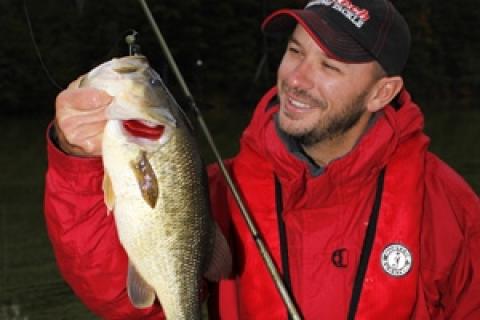
Jigs are renowned for their fish catching abilities. And if I was to hazard a guess, no other lure garners more water time than these weighted bait systems throughout the course of a season.
 For those that target brown and green bass, football jigs are a relatively new wrinkle in this ever-growing genre. They also consistently put fish in the boat. Here is the lowdown on this "Hail Mary" of a bait.
For those that target brown and green bass, football jigs are a relatively new wrinkle in this ever-growing genre. They also consistently put fish in the boat. Here is the lowdown on this "Hail Mary" of a bait.
The Fundamentals of Footballs
Similar in design to a basic lead head, the football jig has a few nuances that greatly improve its performance. The head is more wide and slightly oval (hence the football moniker), allowing it to creep along the bottom with fewer snags, while making a better sound contact with hard structure — namely rocks and boulders.
Due to the forward eye placement, the head is a balanced package when in play, allowing for easier hookups and a more natural bait placement.
Working the Bait
Football jigs were created to replicate crawfish, and as such, should be worked in a similar fashion to the movements of this crustacean. Two retrieves work best for me. The first is dragging. Fairly straight forward in technique and an easy one to learn and perfect. As the name suggests, slowly drag your bait along bottom, varying the distance through the cadence of your pulls, keeping a fairly tight line during the retrieve. I like this movement when working sand and rock structure, as the sediment is kicked up as the jig scurries along the bottom.
Imparting hops into your repertoire is the other. Gliding or lifting your bait off bottom, with a controlled drop back down, is an excellent tactic for fish that are a bit more active.
Search out rocks, points, shoals and flats, and toss football jigs if you know the fish are there. From shallow to deep, they are an excellent bait for dredging up the bottom.
Tools of the Trade
Football jigs can be worked throughout the depths, and are best utilized when fishing deep. For this tactic, go with jigs in the 1/2-ounce size. For average depths, say 8 to 15-feet deep, a 3/8-ounce version is my go-to lure.
Rigging these baits up is when the fun really starts. Living rubber skirts are a great option, especially once the water cools. Plastics get the nod in my boat, and take the form of creature baits, crawfish and tubes. When fish are really on the feed, and again once fall hits, a plastic craw will often trump all others. Both largies and smallmouth love this combination.
When discussing terminal tackle, spinning and baitcast gear can both be utilized. For those that prefer spinning, go with a 6'9" medium-heavy rod. This will provide the backbone that you need. Braid with a fluro leader rounds out the system, and will give you the strength, sensitivity, and minimal stretch that is needed.
I prefer baitcast equipment when working football jigs, as I feel it gives me better control over the jig, as well as an increase in leverage when setting the hook and fighting fish.
- 3356 views

